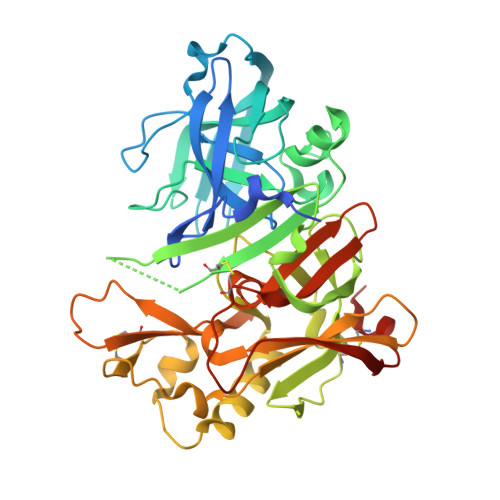Discovery of Potent and Centrally Active 6-Substituted 5-Fluoro-1,3-dihydro-oxazine beta-Secretase (BACE1) Inhibitors via Active Conformation Stabilization
Nakahara, K., Fuchino, K., Komano, K., Asada, N., Tadano, G., Hasegawa, T., Yamamoto, T., Sako, Y., Ogawa, M., Unemura, C., Hosono, M., Ito, H., Sakaguchi, G., Ando, S., Ohnishi, S., Kido, Y., Fukushima, T., Dhuyvetter, D., Borghys, H., Gijsen, H.J.M., Yamano, Y., Iso, Y., Kusakabe, K.I.(2018) J Med Chem 61: 5525-5546
- PubMed: 29775538
- DOI: https://doi.org/10.1021/acs.jmedchem.8b00011
- Primary Citation of Related Structures:
5YGX - PubMed Abstract:
β-Secretase (BACE1) has an essential role in the production of amyloid β peptides that accumulate in patients with Alzheimer's disease (AD). Thus, inhibition of BACE1 is considered to be a disease-modifying approach for the treatment of AD. Our hit-to-lead efforts led to a cellular potent 1,3-dihydro-oxazine 6, which however inhibited hERG and showed high P-gp efflux. The close analogue of 5-fluoro-oxazine 8 reduced P-gp efflux; further introduction of electron withdrawing groups at the 6-position improved potency and also mitigated P-gp efflux and hERG inhibition. Changing to a pyrazine followed by optimization of substituents on both the oxazine and the pyrazine culminated in 24 with robust Aβ reduction in vivo at low doses as well as reduced CYP2D6 inhibition. On the basis of the X-ray analysis and the QM calculation of given dihydro-oxazines, we reasoned that the substituents at the 6-position as well as the 5-fluorine on the oxazine would stabilize a bioactive conformation to increase potency.




















